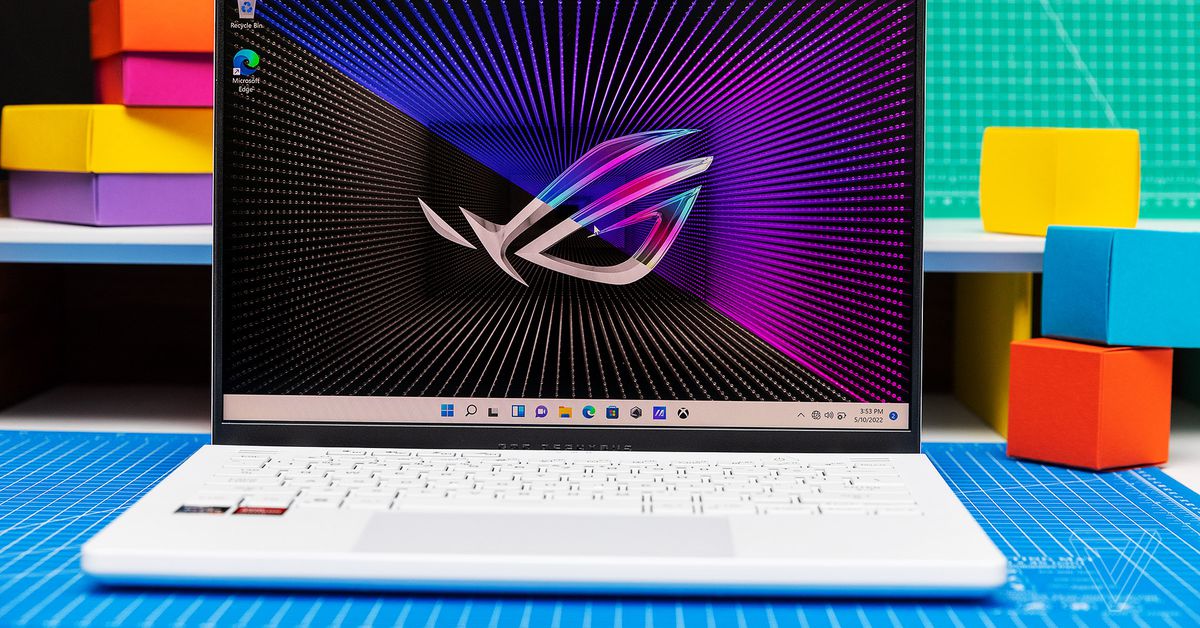
Asus’ entry-level ROG Zephyrus G14 is the one to buy
Devoted Verge readers will remember that I was not the biggest fan of the most recent ROG Zephyrus G14. The model we received had a lot of great things about it — Asus had improved the aspect ratio, added a webcam, enlarged the touchpad, and fixed basically every other complaint I’d had about G14s of the past.
But the unit I had for review was the top SKU, and it was just too expensive.
Specifically, the Radeon RX 6800S / Ryzen 9 6900HS model I received was priced at $2,499.99. That put it in the same price category as some of the market’s most premium 15-inch gaming rigs, including Razer’s Blade 15 Advanced — and way above the price of the larger and better-performing G15. It was not a good deal. But I did note in the review that Asus intended to sell cheaper models of the G14 and that those models, if they produced similar frame rates, could be phenomenal buys.
Well, I’ve finally gotten my hands on one of those cheaper models. I’m typing this right now on a $1,649.99 model of the Zephyrus G14 that has the same Ryzen 9 6900HS processor but swaps that 6800S GPU out for a slightly less powerful 6700S. I’ve strongly suspected for months that this configuration would offer very similar performance to its $2,499.99 counterpart.
And folks, that suspicion has proven correct. The difference in frame rates, while extant, is nothing worth paying for. The 6700S model’s battery life is better. It’s thinner and lighter. The one thing it lacks, which the 6800S has, is a fancy animated light display on the lid. The light display is very cool, and you can go ahead and pay $850 extra for it if you want, but I will say that most people should get the $1,6499.99 model instead. It is hands-down a better deal.
:no_upscale()/cdn.vox-cdn.com/uploads/chorus_asset/file/23470794/akrales_220510_5144_0017.jpg)
For everything related to the G14’s chassis, please see the review of the 6800S G14 that I published in February. There, I detailed the keyboard, touchpad, webcam, screen, and other design and hardware aspects. Those are all the same on the 6700S model, so I’ll just be discussing the performance differences here.
:no_upscale()/cdn.vox-cdn.com/uploads/chorus_asset/file/23470796/akrales_220510_5144_0031.jpg)
The cheaper G14 averaged 189fps on Counter-Strike: Global Offensive at maximum settings and native (2560 x 1600) resolution. The previous model averaged 202fps. This difference will not be noticeable to anyone using these machines since the highest refresh rate the G14’s 120Hz screen can display is 120fps.
You may see an impact on other titles — but not one that is worth $850. The 6700S had some trouble with ray tracing, which almost cut frame rates in half — but that’s exactly what we saw from the 6800S as well. The cheaper model averaged 63fps with ray tracing off and 32fps with ray tracing maxed, where the older model averaged 70fps and 37fps, respectively. Like I said, small potatoes.
And, on Red Dead Redemption 2 with all sliders manually maxed, the cheaper model averaged 45fps where the more expensive SKU averaged 49fps. I promise four frames will not impact your life in any capacity.
Fan noise and heat were similar to what I observed from the 6800S model, which is to say that they were fine. Noise wasn’t particularly annoying during gameplay and didn’t obstruct game audio; when I put the device on the Silent profile for general work, it did indeed become silent. Even during a decent workload that included an external display, there was never more than a bit of warmth on the keyboard. Palm rests were hot during gameplay but not quite uncomfortably so.
:no_upscale()/cdn.vox-cdn.com/uploads/chorus_asset/file/23470795/akrales_220510_5144_0019.jpg)
:no_upscale()/cdn.vox-cdn.com/uploads/chorus_asset/file/23470797/akrales_220510_5144_0042.jpg)
Where I did see something of a difference was battery life. The 6700S model averaged eight hours and 55 minutes of general use at medium brightness, a solid hour over the 6800S. This metric puts the G14 back on the map as one of the longest-lasting gaming laptops of recent years. Gaming battery didn’t show quite the same improvement. I got 46 minutes of Red Dead Redemption 2 play with about 39 minutes of playable time, while I eked 54 and 46 minutes out of the more expensive unit, but gaming battery life is hard to draw conclusions from. Charging time was exactly the same: 60 percent in 41 minutes.
The one other difference between this model and the 6800S is the size. It’s slightly lighter (3.64 pounds to the 6800S’s 3.79 pounds) and thinner (0.73 inches to 0.77 inches). This is obviously not the biggest difference in the world, and it’s quite a light gaming laptop either way. But it is yet another slight advantage the cheaper model has. It’s that much lighter than the Razer Blade 14 and that much more compact than larger machines that can deliver these frame rates. I brought this device on an international trip and loved how light of a load it was in an otherwise packed backpack.
So, the Zephyrus G14 is, once again, one of the better gaming laptops you can buy. You can just go ahead and buy this 6700S model unless you’re really into pretty animated lights. This model is price-competitive with the premium sphere in a way the animated light model isn’t: the closest Razer Blade 14 would be $2,599.99 ($950 more, though with a higher refresh rate screen) and a comparable Alienware X14 (with a lower-resolution screen) would be $1,949. And, it’s very much undercutting larger competitors: the Blade 15 Advanced with an RTX 3070 Ti is currently listed for $2,999.99 ($950 more) as is the RTX 3070 Ti Blade 15 Base (with a lower resolution).
And that’s not even taking into account the other advantages the G14 has over much of the competition, including its lightweight chassis, category-topping keyboard, and (especially) 16:10 screen. The $1,649.99 price point makes it much easier (and more justifiable) to appreciate the real innovations that Asus has made, and continues to make, in this space.
